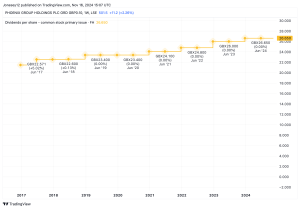A common goal among Stocks and Shares ISA investors is to build a passive income stream. And this desire has only intensified following the cost-of-living crisis that’s plaguing the UK.
With both capital gains and dividends earned inside an ISA immune to taxes, this investing vehicle has become one of the most powerful wealth-building tools in Britain. And in the long run, even an initially modest portfolio can become transformative.
In fact, those with £7,000 in the bank can already get the ball rolling and start their journey to earning £5,000 a month passively and tax-free.
Please note that tax treatment depends on the individual circumstances of each client and may be subject to change in future. The content in this article is provided for information purposes only. It is not intended to be, neither does it constitute, any form of tax advice. Readers are responsible for carrying out their own due diligence and for obtaining professional advice before making any investment decisions.
Crunching the numbers
A £5,000 monthly passive income stream translates to £60,000 a year. That’s almost double the current median salary in the UK. So how large does a portfolio need to be to earn such an income stream? Sadly, the answer’s around £1.5m.
While investors can tweak the 4% withdrawal rule to try and reduce the required portfolio size, investors are still going to likely need a seven-figure Stocks and Shares ISA to sustainably earn £60,000 a year. But as daunting as this sounds, the journey to £1.5m isn’t as impossible as it might seem.
Let’s assume a portfolio can earn a 10% annualised return roughly in line with the stock market average. How long would it take for £7,000 to transform into £1.5m? Just over 53 years.
That’s certainly doable for younger folks but not so much for the older generation. Fortunately, this journey can be massively shortened by throwing in a bit of extra capital each month. On average, UK households save around £450 a month. But if this money were redirected into a 10%-yielding portfolio, the journey to £60,000 annual tax-free ISA income would be shortened to just under 33 years – two decades faster.
What’s the catch?
Even with additional monthly investments, the success of a portfolio still ultimately depends on the return it generates. Index trackers are a terrific tool for replicating the performance of indices like the FTSE 100 and FTSE 250. However, in more recent years, even after the 2024 market rally, these indices have struggled to keep up with their historical performance.
In other words, investors may have to wait considerably longer than expected when relying on index funds. That’s why stock picking remains my preferred strategy. There’s no denying that directly investing in individual businesses comes with significantly higher risk. Apart from demanding far more discipline, research, and knowledge, custom-built portfolios also have a habit of being more volatile.
However, it also opens the door to investing in market-beating opportunities that can be game-changing. Ashtead‘s (LSE:AHT) a prime example of this. The equipment rental group’s management team has demonstrated a knack for capital allocation and international expansion. Subsequently, the business has become the best-performing stock in the UK over the last 20 years.
Since November 2004, shareholders have reaped an average 27.3% annualised return, including dividends. And at this rate, the journey to £1.5m would only take 15 years! Sadly, Ashtead’s massive expansion likely means the days of near-30% annual returns are now likely over for new investors.
But it goes to show the potential of picking winning stocks in the long run. And for investors aiming to earn £5,000 a month passively, these are the sorts of opportunities that will make this dream a reality.
This post was originally published on Motley Fool







